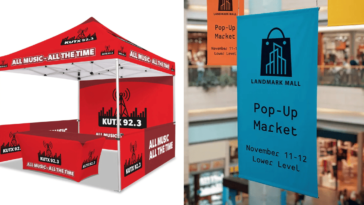It should be easy to set up the canopy tent for your outdoor event, but many people make blunders that are annoying or even dangerous. When erecting their own canopy tents, many people commit the following five blunders:. You may steer clear of these issues to ensure a seamless setup process.
5 Mistakes for a Perfect Canopy Tent Installation
Choosing the Wrong Site
The stability and longevity of your canopy tent depend on your careful placement. Imagine for a second that you’ve pitched your tent on shaky ground and now it trembles and sways with each wind blast. I mean, it’s not exactly the idyllic house you were picturing, was it?
Find the perfect area before you begin erecting your bespoke pop up tents. Before you begin, make sure the area is flat and clear of obstacles like power lines or tree limbs. The ground should also be considered. The ground being too soft or too muddy might be disastrous if your tent is not set up correctly.
Solution
Step one in selecting a location is ensuring that it is both level and has adequate clearance on all sides. Be sure the building remains stable by tightly enclosing each corner. This is of utmost importance when working with loose soil, as stakes may not be as secure. Choosing the correct site the first time around will wind up saving you a ton of hassle.
Missing Anchors
How frequently do you see a dome tent blow away by a strong wind? Guests at your event should not be able to view that. One of the primary causes of these kinds of air excursions, though, is improper grounding.
Inadequately staking your tent or using too few mooring points can expose it to the elements. Do not set it up on any kind of soft ground; doing so increases the risk.
Solution
Do not cut corners when repairing or erecting the canopy tent. Put pegs, weights, or tie-downs in each corner to keep it from moving around, depending on the surface. Longer stakes or heavy-duty anchors might be useful on soft ground to prevent unexpected takeoffs.
Mistaken Sequence of Assembly
When you have finished assembling your dome tent, it is ready for use. Are you sure you’re assembling the pieces in the correct sequence, though? Incorrect assembly of your tent’s components can lead to unsteadiness, instability, and much mental anguish. Even if it’s tempting to just read the directions, trust us when we say that doing so will lead to disaster. If you don’t pay close enough attention to the step-by-step instructions, your Custom canopy tent 10×10 may end up looking more like a haphazard disaster, with unevenly spaced poles and loosely fastened joints, than a sturdy shelter.
Solution
Make sure you read the directions multiple times before you start putting everything together. Verify the correct alignment and secureness of each component before moving on to the next. In the end, it will benefit you.
Disregarding the State of the Weather
Imagine this: Just as you’re about to set up your outside pop-up gazebo for your celebration, ominous clouds roll in. Not strengthening your tent or considering the weather could leave it vulnerable to Mother Nature’s wrath.
Paying no attention to the weather forecast might lead to a disastrously wet occasion, whether it’s high winds that could topple your tent or heavy rain that will convert your cover into a swimming pool.
Solution
Get a head start on bad weather by checking the forecast before you pitch your dome tent. Make sure you enable weather notifications or stay in contact with local assistance if you are in a network zone. You can make your tent stronger by adding additional anchors, and you can make it windproof by adding sides. Also, check that your tent has sufficient drainage in case it starts to rain. You don’t want water to pool inside.
Missing checks and maintenance
You fold up your umbrella tent and store it away after the occasion. At least until next time, you won’t have to think about it. It is incorrect. Your tent’s safety and longevity are compromised if you neglect routine inspections and maintenance, leading to premature wear and tear.
Your canopy tent goes from being a secure place to stay to a potential danger waiting to happen if you ignore the telltale indications of wear and tear.
Solution
Perform maintenance and inspections as part of your post-event routine. After a thorough cleaning and drying, inspect your tent for any indications of damage or wear before storing it. If you want to keep your tent in pristine condition, you should inspect it frequently for faults and address them promptly. This includes the poles, joints, and fabric.
Conclusion
After giving this some thought, you should be able to put up your custom canopy tent without a hitch. Your outdoor canopy tent will serve you well for many seasons to come if you put some thought and effort into its setup.





 No products in the cart.
No products in the cart.